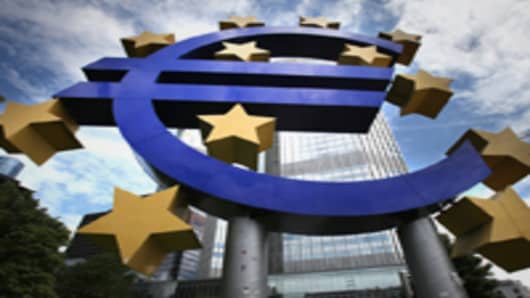2011 was the most dramatic year for the euro in the decade since the single currency was launched.
Countries such as Ireland and Greece had to be bailed out after the cost of their debt soared as the euro zone debt crisis engulfed the region. Italy and Spain—the region’s third- and fourth-largest economies, respectively—looked in danger of needing to seek a bailout.
There has even been speculation that the currency itself will not survive this crisis, which would have been almost unthinkable a year earlier.
While it seems secure for now, experts predict that the value of the euro is likely to fall against the dollar next year.
“The problems with the euro will express themselves most clearly against the dollar,” Simon Derrick, chief currency strategist, BNY Mellon, told CNBC.com. “I thought we would bottom out towards the end of this year, but that looks optimistic now.”
He believes the euro will finish 2012 in the low 1.20 range against the dollar.
The euro, which closed 2010 at 1.3385 against the dollar, has ranged between 1.2950 and 1.4247 this year. It looks set to close down slightly on the year despite market turbulence throughout 2011.
Click here to access a chart showing the annual movements of the euro against the dollar.
European policymakers have bailed out struggling peripheral euro zone countries,issued cheap three-year funding totaling 489 billion euros for the region’s banks, and attended more summits than investors could shake a stick at.
Still, the markets do not appear to be satisfied with the proposed solutions to the economic problems facing the currency bloc, which will continue to affect the valuation of the euro next year.
“As sovereign risks in the Eurozone deepen in 2012, so will the market’s demand for dollars,” currency strategists at UBS wrote in a note.
“The political calendar in the US could spring several policy surprises. However, these are ‘known unknowns’ which the market is arguably more comfortable with compared to the Eurozone’s troubles.”
They predict that the euro will fall to around 1.25 against the US dollar but stay at around 1.20 against the Swiss franc, the level at which the Swiss National Bank has set a floor.
“There will be continued pressure on the euro-dollar for the early part of next year,” Jennifer Hau, foreign exchange strategist at Lloyds Bank Corporate Markets, told CNBC.com. “The market had been looking for a grand plan to solve the euro crisis, but that hasn’t happened, so there will be continued downward pressure on the euro.”
The second auction of cheap three-year loans through a long-term refinancing operation, or LTRO, by the ECB in February will be a key event for the currency in the first quarter, Hau said.
The euro is also set to fall against sterling if the UK continues to be a relative haven, although this could alter if its credit rating comes under further threat, wrote the UBS strategists, who predict that the euro will end 2012 down to 0.83 against sterling.
Scandinavian currencies are also likely to strengthen against the euro, with UBS predicting that the Swedish krona and Norwegian krone will both finish 2012 up substantially, as their economies seem relatively resilient.
Emerging market currencies are unlikely to strengthen hugely on euro weakness, according to Derrick.
“There should be some upward movement in the yen , and both the dollar and the yen should gain ground against riskier assets and currencies,” he said.
There could be some upward movement in the euro if the euro zone situation improves and the trend to short the euro reverses.
“Markets are still extremely short euros, so there could be some upside movement if they square up some of the positions,” said Hau.
As the currency market is increasingly driven by political issues, better-than-expected news from the euro zone could periodically increase the value of the euro against the dollar, the UBS strategists said.
“In any macro scenario, the Eurozone still faces painful adjustment with policy and event risk on many fronts. Foreign exchange volatility is unlikely to mask a major move lower in the euro,” they added.



